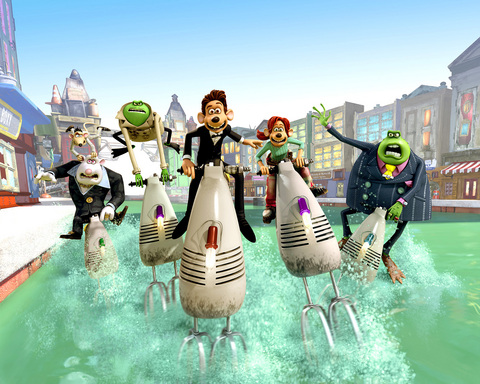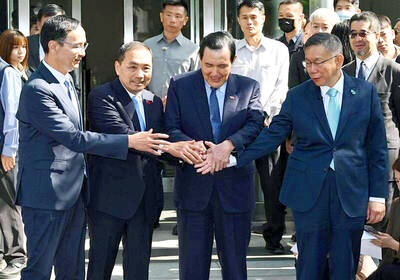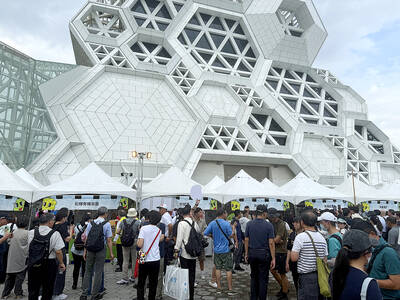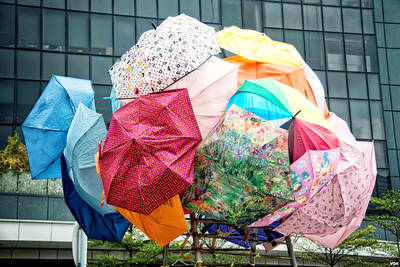Water, water, everywhere — but how do you make it move?
That was the question for the creators of the family film Flushed Away, which tells the tale of a mouse at sea in a sewer.
"Initially, Plan A was to do it stop-frame, actually," said producer Peter Lord. He helped develop the Flushed Away story and is also the co-creator of Aardman Animation, best-known for its stop-motion Wallace and Gromit projects. "But then common sense kicked in and we thought, it's just not going to happen."

PHOTO COURTESY OF UIP
In that type of animation, the puppets, props and background elements are manipulated ever so slightly for each frame of a movie.
But there are only a few materials that mimic water in a stop-motion production, Lord said, including plastic food wrap, glycerin and K-Y Jelly.
And none of those options could work for scene after scene of the sloshing, swirling, rippling, splashing stuff that Roddy the mouse finds himself in when he's flushed down a toilet to a rat-ridden underground re-creation of London.
Lord says the team then considered using puppet characters against a computer-generated background. "But that was ridiculous, actually. That was like making two movies, which is an expensive option."
In the end, Flushed Away is a 100 percent CGI production created at DreamWorks Animation, with inspiration for its look rooted in Aardman's familiar puppet features (broad mouth, narrow teeth, expressive round eyes) and their clay-animation ways of moving.
"There was no question about disguising its Aardman ancestry," Lord said of the collaboration with DreamWorks' computer animators. "So that gave us carte blanche."
"They're so committed and completely giving," Aardman-based director Sam Fell agreed. "You don't need to worry too much about the technical side. You just sort of keep asking for what you want, and they keep giving it to you."
Roddy, voiced by Hugh Jackman, is leading a pampered pet's life in a posh Kensington apartment until a sewer rat invades his home and sends the city mouse down the drain into an adventure among common rodents. In his quest to get home, Roddy meets Rita (Kate Winslet), a street-wise (or canal-wise) rat with a rustic boat and a goal of her own.
"It's like The African Queen, only she's the one with the oily rag around her neck, and he's the guy who'd like a nice cup of tea," Lord said.
Meanwhile, a baddie known as the Toad (Ian McKellen) has various ill intentions — to get a jewel Rita found, which could save her family from poverty, and to wipe out the sewer system's rat population so he can reign supreme. Doing the Toad's dirty work for him is a pair of not-too-bright rats, Spike (Andy Serkis) and Whitey (Bill Nighy).
To do his first animated voice role, Serkis sometimes alternated his DreamWorks recording sessions with his motion-capture work in Peter Jackson's King Kong, giving life to the giant ape. "I was 25-foot-8 (8.7m) by day and a 6-inch (15cm) rat by night," he said.
Serkis said he was drawn to Flushed Away by his longtime admiration for Aardman's Oscar-winning films as well as its knack for bringing out the reality in sometimes outrageous characters.
"I just think the world they've created is so rich, and that whole sewer version of London is such a great world," he said. "There isn't a frame where there isn't a hundred things going on.
"They've got the whole story aspect and the reality of the characters, and yet they've got the ability (with CGI) to take it where they want it. So I think as a marriage of their old style and the new realm — I'm a little bit biased, of course — I think they've done a brilliant job."
It's those qualities that DreamWorks and Aardman are hoping will help Flushed Away stand out among a slew of family-friendly animated features. This is the 10th since January starring personified animals, following solid hits like Paramount's Over the Hedge and also-rans like Weinstein Co.'s Doogal.
"The funny thing is, I hear people saying, 'Oh no, personified animals, too many of them,'" Fell said. "People don't complain that there's a lot of talking-people films — and there's been a lot of them.
"It may be that if the story's good and the films are engaging, there's maybe room for lots and lots more."

It’s Aug. 8, Father’s Day in Taiwan. I asked a Chinese chatbot a simple question: “How is Father’s Day celebrated in Taiwan and China?” The answer was as ideological as it was unexpected. The AI said Taiwan is “a region” (地區) and “a province of China” (中國的省份). It then adopted the collective pronoun “we” to praise the holiday in the voice of the “Chinese government,” saying Father’s Day aligns with “core socialist values” of the “Chinese nation.” The chatbot was DeepSeek, the fastest growing app ever to reach 100 million users (in seven days!) and one of the world’s most advanced and

Has the Taiwan People’s Party (TPP) changed under the leadership of Huang Kuo-chang (黃國昌)? In tone and messaging, it obviously has, but this is largely driven by events over the past year. How much is surface noise, and how much is substance? How differently party founder Ko Wen-je (柯文哲) would have handled these events is impossible to determine because the biggest event was Ko’s own arrest on multiple corruption charges and being jailed incommunicado. To understand the similarities and differences that may be evolving in the Huang era, we must first understand Ko’s TPP. ELECTORAL STRATEGY The party’s strategy under Ko was

The latest edition of the Japan-Taiwan Fruit Festival took place in Kaohsiung on July 26 and 27. During the weekend, the dockside in front of the iconic Music Center was full of food stalls, and a stage welcomed performers. After the French-themed festival earlier in the summer, this is another example of Kaohsiung’s efforts to make the city more international. The event was originally initiated by the Japan-Taiwan Exchange Association in 2022. The goal was “to commemorate [the association’s] 50th anniversary and further strengthen the longstanding friendship between Japan and Taiwan,” says Kaohsiung Director-General of International Affairs Chang Yen-ching (張硯卿). “The first two editions

It was Christmas Eve 2024 and 19-year-old Chloe Cheung was lying in bed at home in Leeds when she found out the Chinese authorities had put a bounty on her head. As she scrolled through Instagram looking at festive songs, a stream of messages from old school friends started coming into her phone. Look at the news, they told her. Media outlets across east Asia were reporting that Cheung, who had just finished her A-levels, had been declared a threat to national security by officials in Hong Kong. There was an offer of HK$1m (NT$3.81 million) to anyone who could assist